Join us on a journey as we delve deep and share the answer to the question on everyone’s mind, “Where do Pine Nuts Come From?”
Let’s explore the origins of these flavorful nuts and discover their history. From the ancient pine forests of the Mediterranean to the modern-day harvests in Asia and North America, let’s uncover the story of “Where do Pine Nuts Come From?”
Where Do Cashews Come From? Find out here
What is a Pine Nut?
Pine nuts are the edible seeds of Pinyon Pine trees. These delicious seeds are a common ingredient in Japanese, Italian, Chinese, Mexican, Afghani, and Russian Cuisine. If you wonder why they are so expensive, it is because of the amount of time a tree takes to grow them. On average, a pine tree needs about 10-12 years to mature before it starts to grow the pine seeds.
Pine Nut Fact: There are approximately 20 species of pine trees that produce edible seeds.
Other Names: Pignoli, Pinoli, Pinon, Indian Nut, Chilgoza, Cedar Nuts
Where Do Pine Nuts Come From?
Pine nuts come from the Pinyon Pine Trees. The two main species of Pine trees that are most famous for delicious edible seeds are Chilgoza Pine and Korean Pine. These nuts are native to the United States, and countries in Europe, America, and Asia are the largest producers.
Talking country-wise, China and Korea are the biggest producers of pine nuts, followed by Afghanistan. Korean pine nut (Pinus koraiensis), the primary type, comes from the countries Mongolia, China, and Korea. In contrast, the Chilgoza Pine nut (Pinus gerardiana), is native to the Northwest Himalayan regions like Afghanistan, Pakistan, and India.
In Europe and the Middle East, pine nuts come from Swiss Pine and Stone Pine trees found in Poland, Germany, France, Italy, Israel, and Syria. Russia and Mongolia are the biggest producers of Siberian pine nuts (Pinus Sibirica) in the world.
What do Pine Nuts Taste like?
Have you ever wondered what pine nuts taste like? These small, ivory-colored seeds have a unique flavor that’s hard to describe but easy to love.
Pine nuts have a distinct nuttiness that’s both rich and delicate at the same time. When eaten raw, they have a subtle sweetness and a creamy, buttery texture that makes them perfect for snacking or adding to salads.
When toasted or roasted, pine nuts take on a deeper, more intense flavor that’s slightly smoky and nutty. This makes them a popular ingredient in many dishes, including pesto, hummus, and baked goods like cookies and cakes.
One thing to note is that pine nuts can be quite expensive, and their flavor can vary depending on the type of pine tree they come from. For example, Italian pine nuts are known for their sweet, buttery flavor, while Chinese pine nuts have a more resinous taste. Why are pine nuts so expensive, you wonder? Read on to find out!
What Does Lychee Taste Like? Find out here
Pine Nuts Nutrition Facts
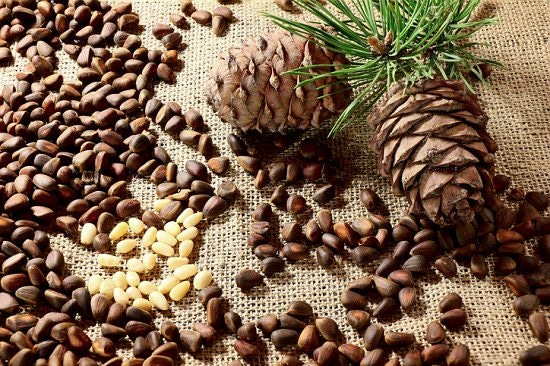
Pine nuts are calorie-rich seeds. One hundred grams of pine nuts carry 673 calories. They also contain Fat, Carbohydrates, Fiber, and Sugar. Pine nuts have numerous health benefits as they are also abundant in Vitamin E, Vitamin-K, Thiamin, and Riboflavin.
- Pine nuts are a rich source of healthy Polysaturated fats, known to improve heart health and reduce levels of cholesterol.
- They are also a rich source of proteins and diet-friendly fiber, promoting satiety.
- They are a rich source of vegan iron and copper, making them perfect for vegetarians!
Is Avocado A Fruit Or Vegetable? Find out here
How To Grow Pine Nuts?
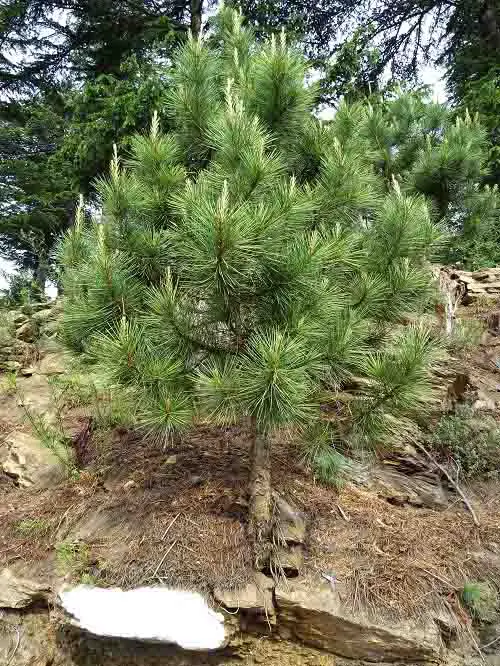
1. Choose the Right Species
Not all pine trees produce edible pine nuts, so it’s important to choose a species that is known for its edible seeds. Some common species include Italian stone pine, Korean pine, and piñon pine.
2. Find a Suitable Location
Pine trees prefer well-draining soil and lots of sunlight, so make sure you choose a spot in your garden that gets plenty of direct sunlight and has good drainage.
Learn some Great Tips to Rejuvenate Your Old Soil here
3. Plant the Seeds
Pine nuts can be planted directly in the ground or in containers. If planting in the ground, dig a small hole and place the seed inside, covering it with soil. If planting in a container, fill the container with potting soil and plant the seed at a depth of about an inch.
4. Water Regularly
Pine trees require regular watering, especially when they’re young. Make sure the soil stays moist but not waterlogged.
Here are the best ways to water plants
5. Be Patient
Growing pine nuts takes time and patience, as it can take several years for the trees to start producing nuts. However, once they do, you’ll have a delicious and nutritious crop of nuts to enjoy!
Here’s everything you need to know about growing a cashew tree!
How to Harvest Pine Nuts?
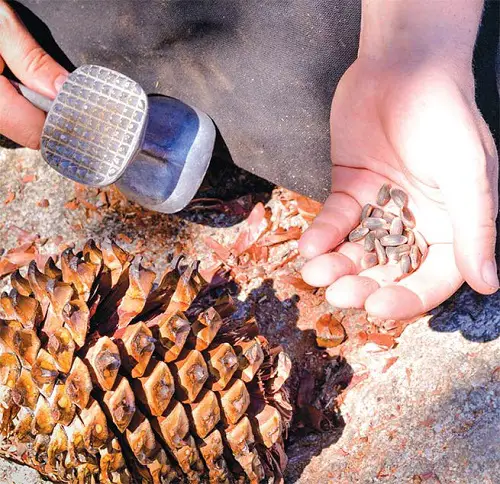
Don’t know how to harvest pine nuts? Harvesting pine nuts is a fun and rewarding activity, especially if you’re lucky enough to have pine trees growing in your area. Here’s how to harvest pine nuts:
- Wait until late summer or early fall when the pine cones turn brown and begin to open up.
- Wear gloves to protect your hands from the sharp needles on the pine cones.
- Use a basket or bucket to collect the pine cones from the tree.
- Place the pine cones in a warm, dry location to allow them to fully open and release the pine nuts.
- Once the cones have fully opened, remove the pine nuts from the cones by hand or by shaking them into a container.
- Discard any empty or damaged nuts, and store the remaining nuts in an airtight container in a cool, dry location until ready to use.
Here are the Best Vegetables that are Ready to Harvest in Less than 2 Months
How to Store Pine Nuts?

To keep your pine nuts fresh and delicious, store them in an airtight container in a cool, dark place, like your pantry or refrigerator. This will help to prevent them from going rancid or losing their flavor over time.
You can also store them in the freezer for even longer-term storage. Just be sure to label the container with the date so you know when they were stored. By following these simple tips, you can enjoy the rich, nutty flavor of pine nuts in your favorite dishes for months to come!
How do Peanuts Grow? Learn here
Frequently Asked Questions
1. Are All Pine Nuts Edible?
Not all pine nuts are edible. Some of these can be toxic, and some may not be flavorful enough for culinary purposes. It’s important to ensure that you’re harvesting pine nuts from a species of pine tree that is known to produce edible nuts. Here are the names of some edible and non-edible pine nut varieties:
Edible Pine Nut Varieties:
- Italian Stone (Pine Pinus pinea)
- Piñon Pine (Pinus edulis)
- Korean Pine (Pinus koraiensis)
Non-Edible Pine Nut Varieties:
- Siberian Pine (Pinus sibirica)
- Single-leaf Pinyon (Pinus monophylla)
2. Why Are Pine Nuts So Expensive?
Pine nuts can be expensive due to the time and effort required to harvest them. Additionally, many pine trees take years to produce pine nuts, which further drives up the cost. The demand for pine nuts is high, but the supply is limited, resulting in higher prices.
3. What Are Pine Nuts Used For?
Pine nuts are a versatile ingredient used in many dishes around the world, particularly in Mediterranean and Middle Eastern cuisine. They add a rich, nutty flavor to salads, pasta dishes, pestos, and baked goods. These are also a key ingredient in traditional dishes like hummus, tabbouleh, and stuffed grape leaves.
4. How Many Pine Nuts in a Pine Cone?
The number of pine nuts in a pine cone can vary depending on the species of the tree. Generally, a single pine cone can contain anywhere from 50 to 100 pine nuts, but some cones may have more or fewer depending on the tree’s health, growing conditions, and other factors.


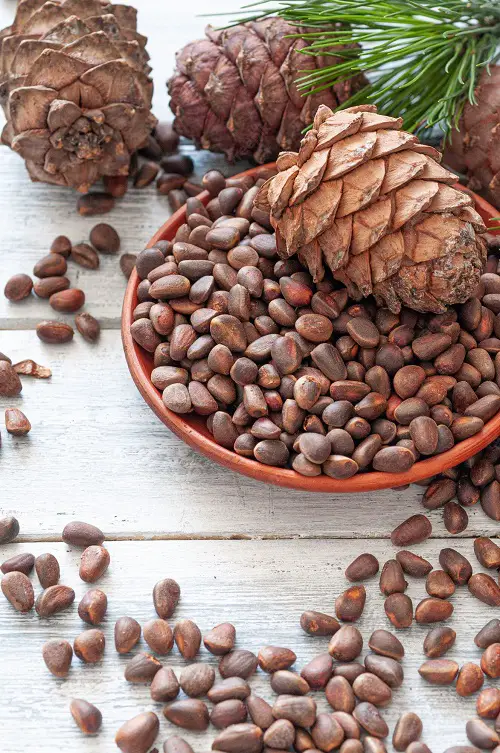

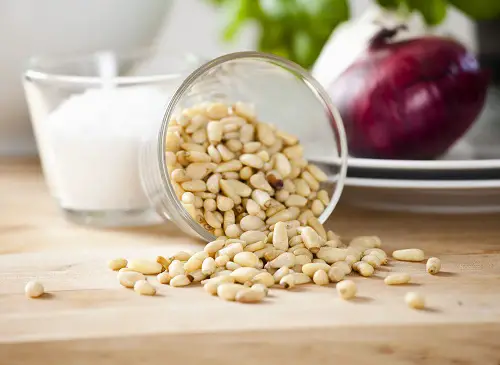

Great